Armored troop carrier TPz 1 Fuchs 8x8 (Germany)
In its original form, the Transportpanzer 1 Fuchs (“Fox Fox Transport Armored Vehicle”) was a wheeled vehicle protected for transporting soldiers weapons. Also on the basis of the chassis, which had large cargo-passenger volumes, special samples were created, such as reconnaissance, sanitary and command-staff vehicles. The new equipment interested the German and foreign military, as a result of which more than 1700 armored vehicles of all modifications for the 12 armies of the world were built.
In the early eighties, the armed forces of the Netherlands showed great interest in the newest German "Fox". However, they did not immediately enter into a contract for the supply of existing equipment. Based on their requirements and needs, the Netherlands military demanded to create a modified version of the armored personnel carrier, differing in the design of the hull and chassis. Such processing of the original project made it possible to increase the number of paratroopers transported and increase the capacity. The increase in characteristics was proposed to be used, first of all, to enhance the firepower.
The finished vehicle with the desired characteristics in the foreseeable future was supposed to go into service and replace the existing BTP YP-408. It should be noted that in parallel, the Dutch designers developed their own project of a new armored personnel carrier on tracked chassis such as YPR-756. Thus, in the event of failure of one of the projects, the army still retained the opportunity to obtain the required equipment.
In response to the requirements of a potential customer, the German development company began to create a new version of the armored personnel carrier. According to reports, a special modification of the machine for the Netherlands received the working designation Transportpanzer 1 Fuchs 8x8. It indicated the original sample, but at the same time reflected the essence of the applied modifications.
To meet the requirements of the customer, the new project envisaged a slight reworking of the hull with an “lengthening” of the chassis and corresponding changes in the transmission. Thus, for a promising BTR, it was necessary to create some new aggregates, while others could be borrowed without change from the existing sample. As a result, the new eight-wheeled vehicle was in fact the Fuchs base armored personnel carrier, supplemented by a stern section with a fourth wheel axle.
The housing for TPz Fuchs 8x8 retained the already well-known design and recognizable shape. It was proposed to weld from relatively thin armor plates, providing protection only from bullets and shrapnel. The front part of the body acted as a control unit. Immediately behind it, at the left side, there was still the engine compartment. At the same time, a significant part of transmission units was located under the floor of habitable compartments. The entire aft part of the hull was a large manned volume intended for the deployment of weapons and troops.
The shape of the body, in general, remained the same. The frontal unit was assembled from several flat sheets, installed at different angles to each other. The forehead itself consisted of three parts, next to which the zygomas were mounted at an angle to the longitudinal axis. Inclined upper front sheet had a large opening for the installation of frontal bulletproof glass. In the cheekbones installed doors that open forward. They had their own glazing. All glasses of the department of management were equipped with folding armored covers with viewing slits.
The central and rear parts of the armor case had the same cross-section along the entire length. The horizontal roof was connected to a pair of side sheets piled inside. Under the latter were horizontal elements. The lower part of the body had a complex shape with several large wheel arches. In this case, their own arches, separated by additional covers, had only two front axles. The third and fourth wheels of each side were placed in the common "compartment". A vertical stern sheet protected the landing from attacks from behind.
During the development of the new project, the German engineers “copied” the back section of the original housing, which contained the main part of the control section, and placed such a “copy” in the rear of the vehicle. This has resulted in the desired internal volume. In addition, the position of the seat for weapons has changed. In connection with the lengthening of the hull, the epaulet for the tower moved from the stern to the central part of the roof.
In the base version, the BV Fox was equipped with a MTU 6V 199 TE20 V6 turbocharged diesel engine with an HP 456 power. According to some reports, the project of the machine TPz Fuchs 8x8 planned to use the same power unit. The available transmission based on the automatic transmission ZF 6HP 602 with six forward speeds and one rear speed was modified in accordance with the change of the chassis. It was supplemented by means of issuing torque to the new aft axle. A gear for driving a pair of propellers was also saved.
After revision, the undercarriage had four axles with large wheels. Bridges with suspension on vertical springs with additional shock absorbers were retained. A lockable differential was mounted in the central part of the bridge. The two front wheels on each side were connected to the control systems.
BTR Transportpanzer 1 Fuchs 8x8 had the means to move through the water. In the stern, behind the fourth axis, a pair of propellers remained, one on each side. There was a wave-reflecting shield on the forehead of the hull, reclined before launching into the water.
The main task of the Fuchs armored personnel carrier was the transportation of troops. In the four-axle version, the machine has increased its potential in this context. An additional section of the hull could be used to install new landing chairs. Three-axle armored vehicle could take on board up to 8 paratroopers. In the new project, according to various data, it was possible to use up to 6-8 new seats - just up to 16 soldiers. Own crew could consist of two or three people, depending on the configuration.
As before, the driver and the commander were to be in the front office. Access to this compartment was provided by side doors. A passage was also envisaged at the starboard side, connecting the control compartment with the landing compartment. Driving outside the combat situation was simplified by large frontal and side glazing. In battle, the armored glass should be covered with metal shields.
Prior to 16, paratroopers were located in an enlarged aft compartment on their own seats, installed along the sides. The main means of landing in the car was aft aft door. In addition, in the roof of the troop compartment there were four rectangular hatches. The paratroopers could observe the situation and fire without leaving the protected volume. On the right side, next to the engine compartment, there was a bulletproof glass with a movable flap. In the stern on each side were placed two inspection devices with an embrasure.
In accordance with the wishes of the army of the Netherlands, the new type of armored personnel carrier had to carry the turret borrowed from the newest YPR-765 combat vehicle. The single turret was completed with an 25-mm Oerlikon KBA-B02 automatic cannon and a rifle caliber machine gun. A set of optical tools was used to observe and search for targets. In addition, the gunner could use a sunroof.
In the future, another version of the combat vehicle, carrying other weapons, could be put into service. Thus, the previous BTR base version was armed with machine gun turrets and anti-tank missiles of various types. Carriers of such weapons could be of interest to the Netherlands.
Staff additional weapons of the machine consisted of six smoke grenade launchers. Block grenade launchers unchanged borrowed from the base armored personnel carrier. Such additional weapons were placed on the left side of the hull, at the level of the engine compartment. Grenade launchers were fixed on a common base with a given elevation angle and a noticeable dilution in the horizontal plane.
Modification of the body has led to a noticeable change in size and weight. The TPz 1 Fuchs 8x8 BTR was longer than 8 m with a width of about 3 m and a height (on the roof of the 2,3 m). New large aggregates led to an increase in mass. The own weight now exceeded 19 t, the combat weight — more than 20 t. The reduction of the specific power struck the mobility. The maximum speed on the highway now did not exceed 85-90 km / h. With the help of propellers, the car accelerated to 8-10 km / h.
The new project was developed on the basis of the existing one, and therefore the design work did not take much time. Soon, under the project TPz 1 Fuchs 8x8 in Germany was built an experienced armored personnel carrier. This machine was designed for testing, organized by the customer and the developer. Together, the two countries planned to test the technique in practice and then draw the necessary conclusions.
According to some reports, from a certain time, the eight-wheeled version of the Fox was tested along with other models of armored vehicles offered to replace the outdated YP-408. Such tests allowed not only to determine the real characteristics of the submitted samples, but also to compare them. According to the results of its own and "competitive" tests, the army of the Netherlands made the necessary conclusions.
During the checks, the YPR-765 tracked armored fighting vehicle of the Netherlands developed best of all. Other samples, including the German Transportpanzer 1 Fuchs 8x8, did not suit the customer. Soon came the order for the supply of another batch of own-produced equipment. With its help, the army in a few years replaced the outdated wheeled armored vehicles.
The only built prototype of the TPz 1 Fuchs 8x8 after completing the tests lost the tower with the weapons, and then went to storage. An interesting car was placed in one of the boxes of the 41 of the military-technical center of the Bundeswehr auto-armored vehicles (Wehrtechnische Dienststelle 41 or WTD 41) in Trier. As far as is known, after the completion of tests in the interests of the Netherlands, this prototype was not used in new projects and in fact stood idle.
From time to time, the 41-th center of automotive armored vehicles organizes exhibitions, during which it demonstrates interesting specimens stored in its garages. The composition of such expositions for some time include the only eight-wheeled armored personnel carrier of the Fox family. This machine, which is markedly different from serial equipment, has consistently attracted the attention of visitors to exhibitions.
The exact reasons for the refusal of the army of the Netherlands from the BTR TPz 1 Fuchs 8x8 unknown. However, the available data on this car allows us to draw some conclusions and understand what its features could have a negative impact on the prospects. The task of increasing the load capacity and increasing the available volumes was successfully solved, but the price of new advantages turned out to be quite high.
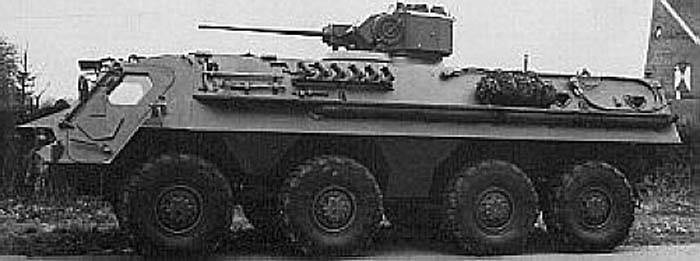
TPz 1 Fuchs 8x8 during the test. Photo Snafu-solomon.com
A characteristic feature of the Fuchs machine in its basic triaxial configuration was its relatively large mass. An added section of the body with a fourth axis led to an increase in this parameter. In addition, the longitudinal dimensions increased markedly, and the tower increased the overall height of the car. After such improvements, the armored personnel carrier no longer fully complied with the requirements of the military transport aviation. The inability to quickly deploy armored vehicles through the air completely leveled all the available advantages.
Instead of the Fuchs 8x8, the YPR-765 tracked vehicle was put into service, which was distinguished by reasonable dimensions and weight. With a length of about 5,3 m, it had a combat mass of no more than 13,6 t. As another development option for the American armored personnel carrier M113, this vehicle could carry no more than ten people, including the crew. The level of protection and firepower of the two samples were the same.
Having considered the presented armored personnel carriers, including a German-made experimental vehicle, the customer, represented by the army of the Netherlands, made its decision. The existing wheeled armored personnel carriers decided to replace their own production of tracked vehicles. From the German BTR Transportpanzer 1 Fuchs 8x8 refused. However, the failure of this version of "Fox" did not affect the further success of the whole family of equipment. Armored personnel carriers and other equipment line, built on the basis of a six-wheeled chassis, still remained in the series and were supplied to various customers.
On the materials of the sites:
http://snafu-solomon.com/
http://military-today.com/
https://strangernn.livejournal.com/
http://al-datr.livejournal.com/
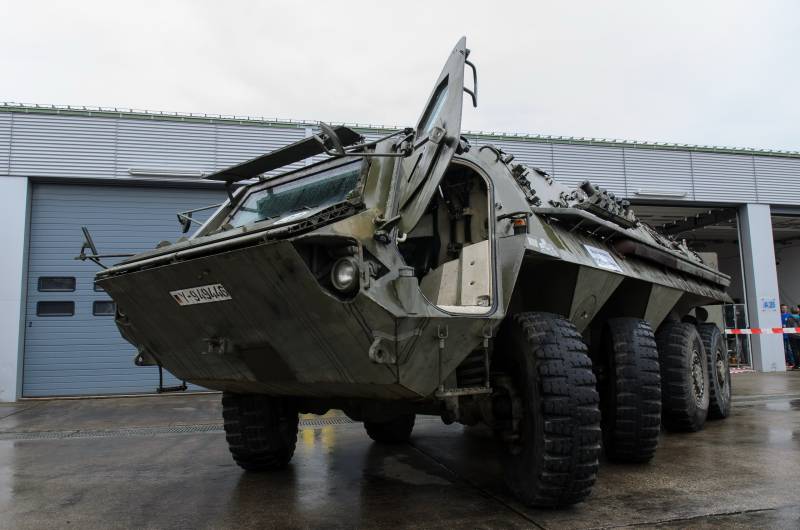

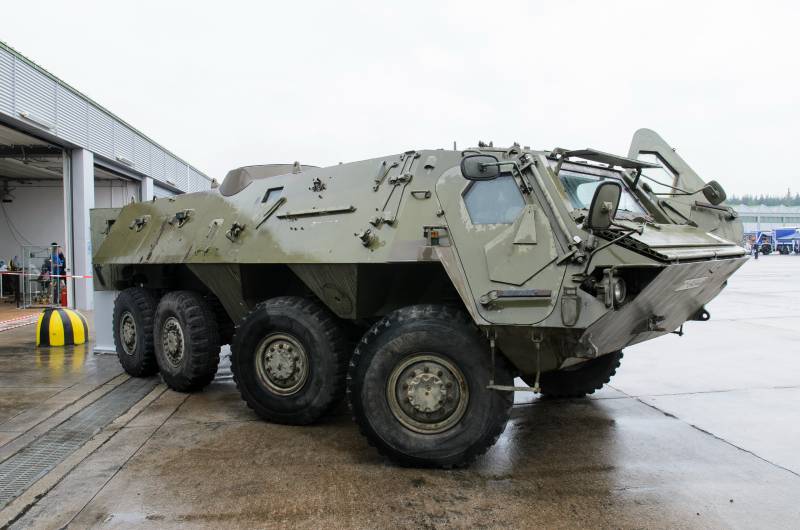
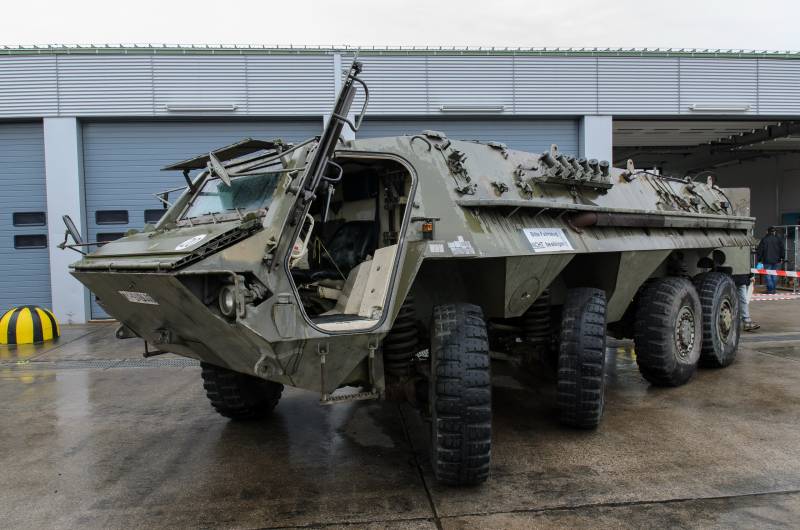
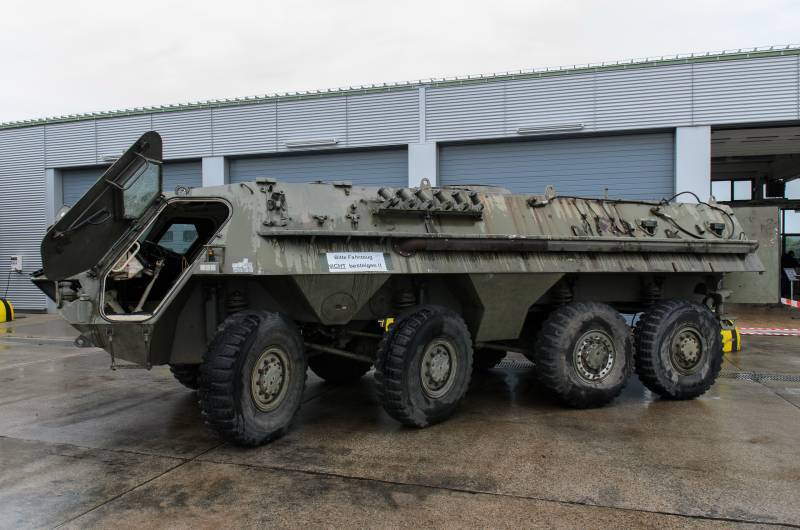

Information